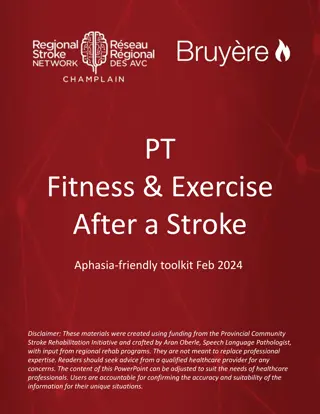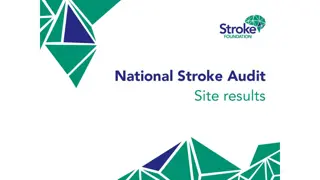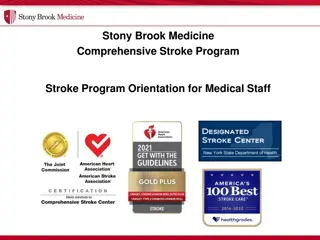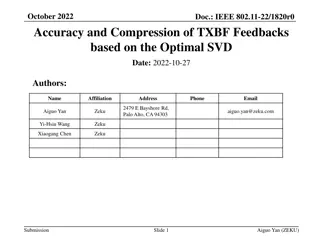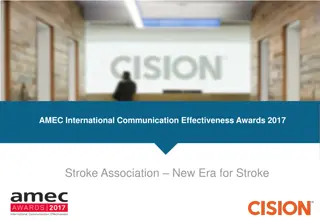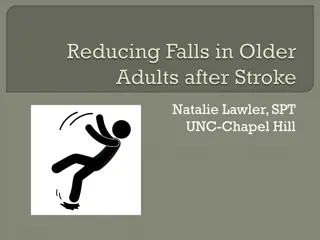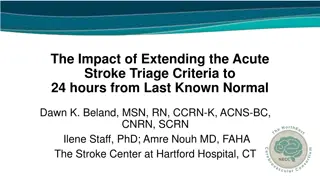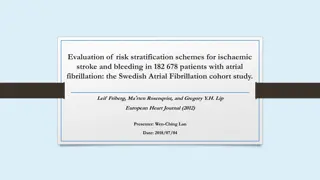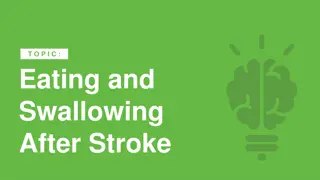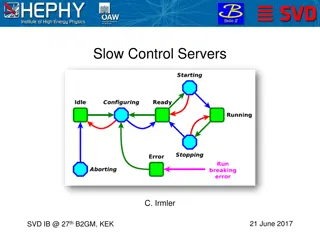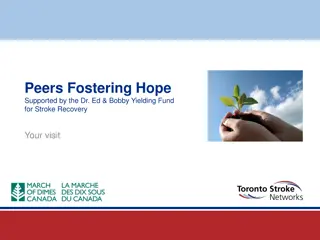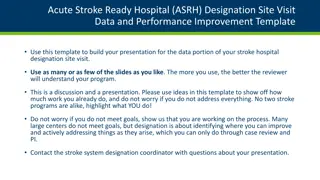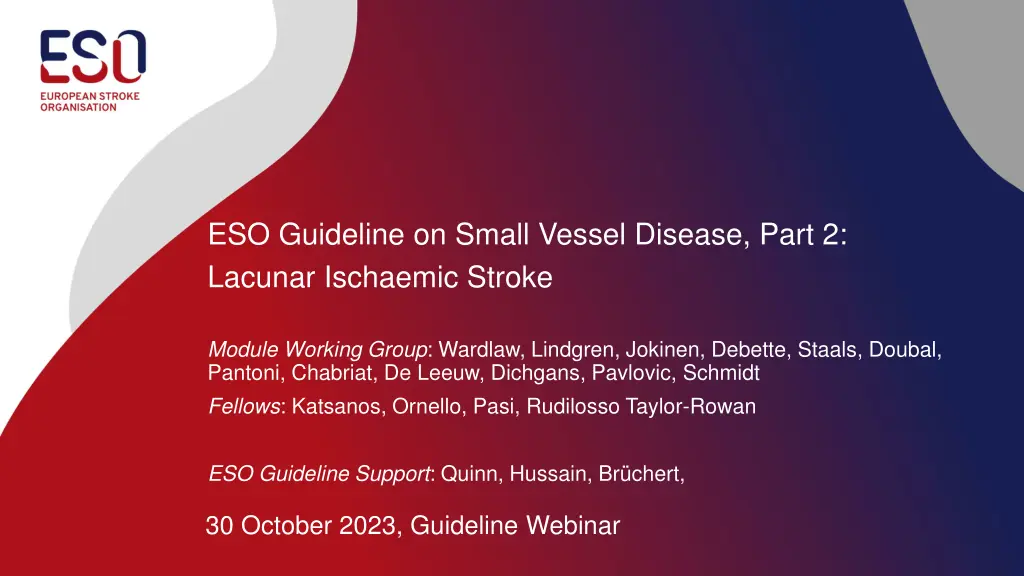
Small Vessel Disease and Lacunar Ischaemic Stroke Guidelines
Explore the essential insights on lacunar ischaemic stroke, a significant form of small vessel disease, including its characteristics, diagnosis challenges, and management strategies outlined in the ESO Guideline. Gain valuable information on the working group members, key recommendations, and outcomes for patients with lacunar ischaemic stroke.
Download Presentation

Please find below an Image/Link to download the presentation.
The content on the website is provided AS IS for your information and personal use only. It may not be sold, licensed, or shared on other websites without obtaining consent from the author. If you encounter any issues during the download, it is possible that the publisher has removed the file from their server.
You are allowed to download the files provided on this website for personal or commercial use, subject to the condition that they are used lawfully. All files are the property of their respective owners.
The content on the website is provided AS IS for your information and personal use only. It may not be sold, licensed, or shared on other websites without obtaining consent from the author.
E N D
Presentation Transcript
ESO Guideline on Small Vessel Disease, Part 2: Lacunar Ischaemic Stroke Module Working Group: Wardlaw, Lindgren, Jokinen, Debette, Staals, Doubal, Pantoni, Chabriat, De Leeuw, Dichgans, Pavlovic, Schmidt Fellows: Katsanos, Ornello, Pasi, Rudilosso Taylor-Rowan ESO Guideline Support: Quinn, Hussain, Br chert, 30 October 2023, Guideline Webinar
Disclosures Intellectual Disclosures: Academic grants from national and international funders for research into epidemiology, clinical and cognitive impacts, mechanisms and treatment of small vessel disease. Editorial roles Clinical trials roles Financial Disclosures: None
Module Working Group Members, Fellows, Support Co-Chairs PICO leads Arne Lindgren Sweden Joanna Wardlaw UK Julie Staals Netherlands Fergus Doubal UK Stephanie Debette France Hanna Jokinen Finland Guideline Members Aleksandra Pavlovic Serbia Hugues Chabriat France Leonardo Pantoni Italy Reinhold Schmidt Austria Frank-Erik De Leeuw Netherlands Martin Dichgans Germany Guideline Fellows Guideline support Aristeidis Katsanos Canada Martin Taylor-Rowan UK Raffaele Ornello Italy Salman Hussain Czech Republic Marco Pasi France Terry Quinn UK Yvonne Br chert Switzerland Salvatore Rudilosso Spain
Lacunar ischaemic stroke An important type of small vessel disease A quarter of ischaemic strokes, often mild Chronic Acute Usually due to intrinsic cerebral small vessel disease, Sometimes due to atherothrombosis or embolism difficult to tell in the clinic Difficult to differentiate from other stroke subtypes clinically in the first few hours Dependency and early recurrent stroke are less frequent than in other stroke subtypes; Cognitive impairment in >50% but often not collected/reported in trials ESO Guideline on Covert cSVD published ESJ May 2021
Guideline overview lacunar ischaemic stroke Patients: with suspected lacunar ischaemic stroke not included: covert cSVD, haemorrhage, cognitive, other stroke+cSVD presentations Interventions: Acute 1. Thrombolysis 2. Antiplatelets 3. Antihypertensive 4. Progressing 5. Other interventions Secondary Prevention 6. Antiplatelets 7. Antihypertensive 8. Lipid lowering 9. Lifestyle interventions 10. Other interventions Comparator: Avoidance of, or less intensive intervention Outcomes: 1. Stroke (ischaemic or haemorrhagic) 2. Dependency 3. Death 4. Cognitive decline or dementia 5. Major adverse cardiovascular events 6. Mobility or gait disorder 7. Mood disorders including depression
Issues lacunar ischaemic stroke Total literature assessed = >4689 hits, Average >662/ PICO very few trials provided data on stroke subtypes few trials subtyped stroke vanishingly few trials in lacunar stroke most lacunar stroke is mixed amongst other stroke subtypes Heterogenous terminology and definitions searching and extraction difficult We performed numerous new meta-analyses and network meta-analyses Close cross-reference to other relevant ESO Guidelines to avoid inconsistencies
PICO 1, Acute, thrombolysis treatment Does thrombolytic treatment (including at extended time window and wake-up stroke, alteplase/tenecteplase/other), compared to avoiding this intervention/other thrombolytic/dose/etc, reduce recurrent ischaemic stroke, dependency, death, cognitive impairment or dementia, haemorrhagic stroke, MACE, mobility or gait disorder, and mood disorders? 897 abstracts, 47 full text review, 6 studies for data extraction from 5 RCTs Subgroups of: NINDS, IST-3, Wake-UP, [ENCHANTED, PRISMS] 524 patients alteplase vs control Good functional outcome, 3 trials, OR 1.36 [0.73, 2.55] sICH, death, 1 trial
PICO 1, acute, thrombolysis treatment Does thrombolytic treatment (including at extended time window and wake-up stroke, alteplase/tenecteplase/other), compared to avoiding this intervention/other thrombolytic/dose/etc, reduce recurrent ischaemic stroke, dependency, death, cognitive impairment or dementia, haemorrhagic stroke, MACE, mobility or gait disorder, and mood disorders? Evidence-based Recommendation We suggest that patients with suspected acute lacunar ischaemic stroke should be assessed for and receive treatment with 0.9 mg/kg alteplase according to current guidelines for the treatment of acute ischaemic stroke, since the limited data available suggest that the outcomes for patients with lacunar ischaemic stroke are consistent with the overall results of alteplase trials. Quality of evidence: VeryLow Strength of recommendation: Weak for intervention ? Data are very limited; Lacunar stroke is difficult to diagnose acutely; Power is limited.
PICO 1, acute, thrombolysis treatment Expert Consensus Statement 1. Twelve of 12 MWG members agreed that in patients with suspected acute lacunar ischaemic stroke, with no contraindication to thrombolytic treatment according to current clinical guidelines for thrombolytic treatment (including wake up stroke), there is no evidence for withholding thrombolytic treatment. Therefore these patients should receive intravenous alteplase at standard dose (0.9mg/kg) as quickly as possible according to current clinical guidelines. 2. Twelve of 12 MWG members agreed that in patients with suspected acute lacunar ischaemic stroke there are insufficient data to support use of thrombolytic drugs other than alteplase, or a lower dose of alteplase (unless there is another reason) at the present time. Consistent with Berge et al, ESO GL on thrombolysis, ESJ 2021
PICO 2 & 6, antiplatelet treatment, acute and secondary prevention Does antiplatelet treatment, acutely or long-term (considering single/dual, duration, and whether any particular antiplatelet or combination of antiplatelets is better), compared to avoiding/less of/alternative antiplatelet intervention, reduce recurrent ischaemic stroke, dependency, death, cognitive impairment or dementia, haemorrhagic stroke, MACE, mobility or gait disorder, and mood disorders? 737 abstracts, 110 full text review, 29 for data extraction from 25 RCTs 3 PICO 2, 22 PICO 6 PICO2= Acute: CAST, IST, aspirin v placebo (N=10,879); TARDIS, 3 APT vs standard, N=1,288; Meta-analysis not possible: different outcomes CHANCE-2, N=1750, recurrent stroke ticagrelor+asp 3.6% vs clopidogrel+asp 7.0% PICO6= Secondary: aspirin, clopidogrel, dipyridamole, ticlopidine, ticagrelor, cilostazol, prasugrel, terutroban, triflusal, voraxapar Different combinations, comparators, outcomes, large heterogeneity, 9 meta-analyses 3 network meta-analyses - exploratory
PICO 2, antiplatelet treatment, acute Does acute treatment with antiplatelets (considering single/dual, duration, and whether any particular antiplatelet or combination of antiplatelets is better), compared to avoiding/less of/alternative antiplatelet intervention, reduce recurrent ischaemic stroke, dependency, death, cognitive impairment or dementia, haemorrhagic stroke, MACE, mobility or gait disorder, and mood disorders? Evidence-based Recommendation In patients with suspected acute lacunar ischaemic stroke, there is continued uncertainty about a specific combination of antiplatelet therapy over monotherapy. Quality of evidence Very low Strength of recommendation: - Expert Consensus Statement Twelve of 12 MWG members agree with the statement that in patients with suspected lacunar ischaemic stroke, initiation of antiplatelet therapy should be started as soon as possible after stroke onset. Comment: It may be reasonable to use dual antiplatelet therapy short term according to the CHANCE and POINT trials protocols. Comparable with Dawson et al, ESO expedited GL 2021.
PICO 6, antiplatelet treatment, secondary prevention Recurrent stroke: Meta-analysis: Clopidogrel, ticagrelor, ticlopidine, etc, not superior to aspirin alone SPS3 and MATCH showed no benefit but increased risk of clopidogrel+aspirin versus aspirin or clopidogrel alone
PICO 6, antiplatelet treatment, secondary prevention Exploratory Network Meta-analysis Any recurrent stroke N=21080 RR (95%CI) (0.41, 0.77) Aspirin+Dipyridamole vs Placebo 0.56 Cilostazol vs Placebo 0.55 (0.36, 0.84) Clopidogrel vs Placebo 0.59 (0.42, 0.83) To reduce any recurrent stroke Exploratory, often indirect, all low certainty evidence
PICO 6, antiplatelet treatment, secondary prevention Does long-term treatment with antiplatelets (single/dual, duration, and whether any particular antiplatelet or combination of antiplatelets is better), compared to avoiding/less of/alternative antiplatelet intervention, reduce recurrent ischaemic stroke, dependency, death, cognitive impairment or dementia, haemorrhagic stroke, MACE, mobility or gait disorder, and mood disorders? Evidence-based Recommendation In patients with suspected lacunar ischaemic stroke, for secondary prevention of long-term adverse outcomes, we recommend long term single antiplatelet therapy with aspirin or clopidogrel from 2-4 weeks after stroke onset. Quality of evidence: Moderate Strength of recommendation: Weak for intervention ? Expert Consensus Statement 1. In patients with suspected lacunar ischaemic stroke, 12 of 12 MWG members recommend against the use of long-term* dual or triple antiplatelet therapy. Instead, single antiplatelet therapy should be used as per the Evidence Based Recommendation above, unless other conditions warrant a combination of these medications. * Defined as more than 2-4 weeks 2. In patients with suspected lacunar ischaemic stroke, 11 of 12 MWG members agreed that the current evidence was inadequate to recommend routine use of cilostazol to prevent adverse long term outcomes. Consistent with Dawson et al ESO Guideline on secondary stroke prevention, ESJ 2022
PICO 3 & 7, antihypertensive treatment, acute and secondary prevention Does antihypertensive treatment, given acutely or long term (considering agent and BP target), compared to avoiding this intervention, reduce recurrent ischaemic stroke, dependency, death, cognitive impairment or dementia, haemorrhagic stroke, MACE, mobility or gait disorder, and mood disorders? 961 abstracts, 99 full text review, 11 data extraction from 7 RCTs: PICO 3, 5 RCTs; PICO 7, 2 RCTS PICO3= Acute: CATIS, SCAST, ENOS, VENTURE, ENCHANTED; N=3567 patients Data on dependency, 5 trials; ICH 1 trial; MACE, 2 trials; depression, 1 trial. PICO7= Secondary: SPS3, N=3020, SBP target 130 149 vs < 130 mm Hg PRESERVE, n=111, SBP target 130 140 vs <125 mmHg Data on recurrent stroke, MACE, ICH, cognition
Meta-analysis, antihypertensive treatment, acute and secondary prevention PICO 3 Acute BP lowering, functional outcome (mRS 0-2): No difference with thrombolysis OR 0.99 (0.50-1.27) P=0.97 MACE, 2 trials, HR: 1.75 (0.68-4.52). ICH, depression, 1 trial each, neutral PICO 7 Secondary prevention, BP lowering to target, recurrent stroke: RR 0.87 (0.68 1.10) P=0.25 MACE, cognitive function, neutral. ICH reduced
PICO 3, antihypertensive treatment, acute Does immediate antihypertensive treatment (considering agent and BP target), compared to avoiding this intervention, reduce recurrent ischaemic stroke, dependency, death, cognitive impairment or dementia, haemorrhagic stroke, MACE, mobility or gait disorder, and mood disorders? Evidence-based Recommendation 1.In hospitalized patients with suspected acute lacunar ischaemic stroke and BP <220/110 mmHg, not treated with intravenous thrombolysis, we suggest against the routine use of blood pressure lowering agents in the hyperacute phase, unless this is necessary for a specific comorbid condition. Quality of evidence: Low Strength of recommendation: Weak against intervention ? 2. In patients with suspected acute lacunar ischaemic stroke undergoing intravenous thrombolysis we suggest following the same guideline as in acute ischaemic stroke at large, i.e. maintaining BP below 185/110 mmHg before bolus and below 180/105mmHg after bolus, and for 24 hours after alteplase infusion. Quality of evidence: Very Low Strength of recommendation: Weak for intervention ? 3. In patients with suspected acute lacunar ischaemic stroke there is continued uncertainty over the benefits and risks of temporarily stopping versus continuing previous blood pressure lowering therapy. Quality of evidence: Very Low Strength of recommendation: -
PICO 3, antihypertensive treatment, acute Expert Consensus Statement 1. 12 of 12 MWG members agreed that there is insufficient evidence at present to provide a precise timeframe during which BP lowering agents should be avoided in patients with suspected acute lacunar ischaemic stroke. Based on current limited evidence, blood pressure lowering therapy should be avoided for at least 24 hours after symptom onset. 2. When antihypertensive drugs need to be used in patients with suspected acute lacunar ischaemic stroke undergoing intravenous thrombolysis and with BP > 180/105mmHg, 12 of 12 MWG members agreed that there is no advantage/disadvantage of one antihypertensive medication over another, hence any antihypertensive drug may be used, as long as blood pressure is closely monitored. 3. 11 of 12 MWG members agreed that in patients with suspected acute lacunar ischaemic stroke not treated with intravenous thrombolysis and blood pressure >220/120 mmHg, careful blood pressure reduction (<15% systolic blood reduction in 24 hours) is reasonable and likely to be sage. No specific blood pressure lowering agent can be recommended. Consistent with Sandset et al ESO Guideline on acute BP management, ESJ 2021
PICO 7, antihypertensive treatment, secondary prevention Evidence-based Recommendation In patients with suspected/presumed lacunar ischaemic stroke we recommend the use of antihypertensive treatment to prevent recurrent stroke and MACE. Quality of evidence: Moderate Strength of recommendation: Strong for intervention Expert Consensus Statement In patients with suspected/presumed lacunar ischaemic stroke for secondary prevention: 1. All group members suggest that: BP should be appropriately monitored and well controlled, when possible through use of out of office blood pressure measurements. We cannot advise any specific antihypertensive treatment. 2. All but one group members agree that aiming for BP <130/80 mmHg as generally recommended for patients with previous ischaemic stroke or TIA may be reasonable, but that drastic BP reductions and important BP variability should be avoided, probably targeting SBP between 125 and 130 mmHg and DBP between 70 and 80 mmHg. Consistent with Dawson et al ESO Guideline on secondary stroke prevention, ESJ 2022
PICO 8, lipid lowering, secondary prevention Does lipid lowering (considering a particular agent, dose, target), compared to less intense or avoiding this intervention, reduce recurrent ischaemic stroke, dependency, death, cognitive impairment or dementia, haemorrhagic stroke, MACE, mobility or gait disorder, and mood disorders? 575 abstracts; 23 papers full text; 2 RCTs included, N=2415. SPARCL atorvastatin 80 mg daily vs placebo; 4.9 yrs; 1407/4731 had small vessel stroke Primary outcome any stroke J-STARS pravastatin 10mg daily vs placebo; 4.9 yrs; 1006/1578 had lacunar stroke Primary outcome stroke/TIA, 49 vs 47, RR 0.93 [0.77, 1.12] p=0.43
PICO 8, lipid lowering, secondary prevention Does lipid lowering (considering a particular agent, dose, target), compared to less intense or avoiding this intervention, reduce recurrent ischaemic stroke, dependency, death, cognitive impairment or dementia, haemorrhagic stroke, MACE, mobility or gait disorder, and mood disorders? Evidence-based Recommendation There is continued uncertainty regarding the effect of lipid lowering specific to lacunar stroke. However we recognise that lipid lowering is effective in reducing clinically adverse outcomes in patients with undifferentiated ischaemic stroke. Quality of evidence: - Low Strength of recommendation: - Expert consensus statement Twelve of 12 MWG members agreed that patients with lacunar ischaemic stroke should receive lipid lowering therapy given there is some evidence of benefit and no clear evidence of harm. Consistent with Dawson et al, ESO Guideline on secondary stroke prevention, ESJ 2022
PICO 9, lifestyle intervention, secondary prevention Does treatment with lifestyle interventions [e.g. smoking cessation, dietary interventions, weight reduction, physical exercise, cognitive/behavioural or social interventions, sleep/CPAP, or a mixture of these], compared to less intense or avoiding this intervention, reduce recurrent ischaemic stroke, dependency, death, cognitive impairment or dementia, haemorrhagic stroke, MACE, mobility or gait disorder, and mood disorders? 632 abstracts; 24 papers full text; 3 papers (2 RCTs) included. 2 RCTs addressing the effect of lifestyle interventions in patients with lacunar ischaemic stroke: One - physical exercise: HITPALS, n=63, recent lacunar ischaemic stroke 3-month home-based high-intensity interval training (15 minutes a day, 5 days per week vs usual care. Primary outcome - cardiorespiratory fitness (Graded Cycling Test with Talk Test) No difference in other outcomes One - dietary (B vitamins): VITATOPS, n=230, recent lacunar ischaemic stroke, MCI, Daily B vitamins or placebo Primary outcome cognitive change at 5 years - no effect
PICO 9, lifestyle intervention, secondary prevention Does treatment with lifestyle interventions [e.g. smoking cessation, dietary interventions, weight reduction, physical exercise, cognitive/behavioural or social interventions, sleep/CPAP, or a mixture of these], compared to less intense or avoiding this intervention, reduce recurrent ischaemic stroke, dependency, death, cognitive impairment or dementia, haemorrhagic stroke, MACE, mobility or gait disorder, and mood disorders? Expert consensus statement Despite lack of direct evidence, 12 of 12 MWG members suggest that it is advisable to promote healthy lifestyle modifications in patients with lacunar stroke as recommended in secondary prevention for stroke and VCI. These include regular physical exercise, maintaining healthy body weight, avoiding smoking and excess alcohol, and eating a healthy balanced diet with low sodium intake.
PICO 5 & 10: Other treatment, acute and secondary prevention Does acute treatment with other agents, compared to less intense or avoiding this intervention, reduce recurrent stroke, recurrent ischaemic stroke, dependency, death, cognitive impairment or dementia, haemorrhagic stroke, MACE, mobility or gait disorder, and mood disorders? e.g. Phosphodiesterase inhibitors-3 inhibitors [e.g. cilostazol, pentoxifylline], anti-inflammatory agents [e.g. minocycline], anticoagulants, Nitric Oxide donors [e.g. transdermal glyceryl trinitrate], Phosphodiesterase inhibitors-5 [sildenafil, tadalafil, dipyridamole], or other relevant agents [e.g. heparin] not in other PICOs PICO5= Acute: avoid GTN, heparin/LMW heparinoid, Xueshuantong; uncertainty for Magnesium, cilostazol, other agents PICO10= Secondary prevention: cannot recommend any agents e.g. phosphodiesterase inhibitors- 3 inhibitors, anti-inflammatory agents, anticoagulants, nitric oxide donors, phosphodiesterase inhibitors-5, etc; avoid anticoagulation unless the patient has AF. PICO 4, acute lacunar ischaemic stroke and progressive symptoms Do antiplatelets/anticoagulants/thrombolysis/other agent, compared to avoiding this intervention, reduce recurrent ischaemic stroke, dependency, death, cognitive impairment or dementia, haemorrhagic stroke, MACE, mobility or gait disorder, and mood disorders? Answer to PICO4 question: No.
Conclusion: patients with suspected/presumed lacunar ischaemic stroke Treat with alteplase according to thrombolysis guidelines Start antiplatelet treatment ASAP Use single antiplatelet long term No evidence to support BP reduction acutely Manage BP in secondary prevention but no evidence for low targets or specific drug Lipid lowering limited data no evidence of harm Lifestyle modifications should be encouraged Other treatments avoid GTN, heparin acutely; no evidence for others Patients with lacunar stroke and AF should receive anticoagulation, and strict risk factor control Progressive lacunar stroke, no evidence; trials needed
Limitations Subgroup analyses; noisy subtyping; limited power; incomplete range of outcomes lack of conventionally reliable data on acute treatment or secondary prevention Future research All trials in ischaemic stroke should: subtype stroke report outcomes by stroke subtype, clearly defined. Trials in lacunar stroke should: be sufficiently powered to answer the research questions always report basic clinical outcomes - safety, cognitive impairment, dependency, recurrent stroke, also when not being primary outcomes use standardised assessment tools throughout
Module Working Group Members, Fellows, Support Co-Chairs PICO leads Thank you Arne Lindgren Sweden Joanna Wardlaw UK Julie Staals Netherlands Fergus Doubal UK Stephanie Debette France Hanna Jokinen Finland Guideline Members Aleksandra Pavlovic Serbia Hugues Chabriat France Leonardo Pantoni Italy Reinhold Schmidt Austria Frank-Erik De Leeuw Netherlands Martin Dichgans Germany Guideline Fellows Guideline support Aristeidis Katsanos Canada Martin Taylor-Rowan UK Raffaele Ornello Italy Salman Hussain Czech Republic Marco Pasi France Terry Quinn UK Yvonne Br chert Switzerland Salvatore Rudilosso Spain


